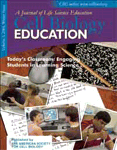Role of the Undergraduate Student Research Assistant in the New Millennium
Abstract
In this study, we analyze the contribution of the undergraduate student who participates in the process of generating scientific data and developing a research project using Brazilian research as an example. Historically, undergraduate students have performed the critical role of research assistants in developing countries. This aspect has been underappreciated as a means of generating scientific data in Brazilian research facilities. Brazilian educational institutions are facing major age-related generational changes among the science faculty within the next 5–10 yr. A lack of adequate support for graduate students leads to a concern that undergraduates will not be interested in choosing research assistant programs and, subsequently, academic research careers. To remedy this situation it is important to focus on ways to encourage new research careers and enhance university–industry collaborations.
Undergraduate research is an inquiry or investigation conducted by an undergraduate that makes an original intellectual or creative contribution to the discipline, according to the Council on Undergraduate Research, a U.S. organization whose goal is to strengthen science, mathematics, and engineering research programs at predominantly undergraduate institutions (CUR, 2004). Most undergraduate research assistant programs offered by world-renowned universities such as Stanford, Oxford, Harvard, and Cambridge seek to provide research opportunities for undergraduates during the academic year. Program emphasis is usually on providing incentives to attract outstanding undergraduates, encouraging students to consider fields of graduate study, and extending the undergraduate curriculum by providing opportunities for becoming a critical part of research. At the end of the calendar year, most programs ask the undergraduate research assistant to complete and submit a final report summarizing the research activity and results.
Developing countries face limitations in keeping pace with the exponential growth of information from scientific research. Brazil is the largest Latin American country. A distinctive feature of its research is that most of it is still performed within governmental universities (de Meis et al., 2003). The Brazilian academy is traditionally focused on basic science, but in recent years, it has been directing more effort to applied science and industrial research. In this context, undergraduate research programs with intensive work in the laboratory, similar to those offered by world-renowned universities, clearly have been of enormous benefit to Brazil. Each year more laboratories are available, offering different aspects of advanced research to their undergraduate students. These students have clearly contributed to the coming of age in certain fields of science not only in Brazil but at least in some countries of Latin America. They have learned with the experience derived from a very special scheme that deserves attention and recognition (González, 2001).
ENTRANCE PATHWAYS TO THE SCIENTIFIC CAREER IN BRAZIL
In practice, two major tracks lead to a career in scientific research in Brazil. The most commonly used pathway for undergraduate students is to go through an undergraduate research program during their college years, followed by a Master of Science program, Doctoral program, or both. Although uncommon, undergraduate students can also follow straight to graduate training or to specialization, having the option of an alternate pathway (Figure 1). Their formal training usually takes place in departments at colleges, universities, or in hospital-based training programs. Most of the institutions that offer undergraduate research programs in Brazil are free, without tuition fees. At present, only a small number of private or nongovernmental universities and colleges have a developed research facility. The Brazilian undergraduate students do not pay for the training and some of them receive a fellowship while they are involved in a research project (Figure 1).
UNDERGRADUATE STUDENT RESEARCH ASSISTANTS (USRA) AND ACADEMIC RESEARCH CENTERS
Statistical data from the Brazilian National Council for Scientific and Technologic Development (CNPq), which is responsible for the accreditation of nearly 80 percent of the Brazilian USRA fellowships, reveal that Brazilian undergraduate research assistants are men (46 percent) and women (54 percent), 20–24 yr old, who volunteer for an undergraduate research program (CNPq, 2003a). Until recently, only a small number of undergraduate students were interested in graduate programs. Therefore it was necessary for the Brazilian advisors to arrange for the undergraduate students to play an increasing role in their projects while preparing them as candidates for a research career. According to data published last year by CNPq and the Coordination for the Advancement of Higher Education staff (CAPES), undergraduate student research assistant fellowships make up nearly 35 percent of the total of fellowships granted for scientific research programs in Brazil, whereas only 6 percent are granted to postdoctoral fellows (CAPES, 2003; CNPq, 2003b; Figure 2). In fact, reliable statistics for the number of undergraduate research assistants are not available because many do not receive a fellowship and therefore are not included. Therefore, these results tend to underestimate the participation of USRAs in Brazilian scientific research.
Figure 1. Entrance pathways to a scientific career in Brazil. Common prerequisites are listed to the left of the training programs. Downward arrows indicate routes of progression among programs. Fellowship values are shown on the right. *The fellowship values for research scientists vary according to their productivity (U.S.$284.15–$381.32) and supplement their academic salaries.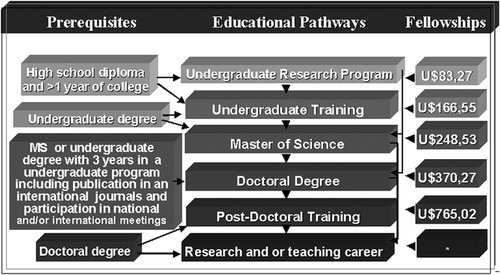
It is important to point out that Brazilian expenditures in science and technology decreased significantly from 1996 to 2002, from about U.S.$1,750 million to approximately U.S.$500 million (de Meis, 2003). On the other hand, the number of USRA fellowships has increased over the last 20 yr, from 1,079 in 1980 to 18,483 in 2000 (Figure 3A). The increase in the number of USRA fellowships granted is still not occurring as rapidly as the increase in total number of Brazilian undergraduate students (Figure 3B). In 2002, among the 3,479,913 students enrolled in Brazilian universities and facilities, only 18,861 were granted a CNPq fellowship. Unfortunately, the ratio between these two groups has declined steeply in the last 10 yr (Figure 3C). The increase in the total number of undergraduate students in Brazil is mainly a result of the new private universities that have been created in this period (de Meis, 2003). These data indicate the need for additional support for the USRA programs in universities with qualified research groups.
Interestingly enough, most of the USRA fellowships granted are in the southeastern region (49 percent), where the greatest number of researchers and graduate programs are concentrated (Figure 4). This unequal regional distribution has probably indirectly contributed to making the Southeast the most developed region of Brazil in terms not only of research but also of technological development. Brazilian proteomics and genomics projects are numerous in this region, where research of the biggest scientific groups is consistently maintained (Rabinowicz, 2001; Simpson et al., 2000).
GOOD... AND A BARGAIN!
Because of their relatively low cost (see Figures 1, 3), USRAs usually find openings in important projects in universities, research centers, and hospital laboratories. As a consequence, their scientific knowledge increases in proportion to their direct participation. Interestingly, 61 percent of these USRAs have published as first author or coauthor during their undergraduate research participation (CNPq, 2002). In Brazil, the number of papers published in international journals has expanded steadily (de Meis et al., 2003a; Macilwain, 1999). The rate of publication in refereed journals is one of the criteria recently adopted by CAPES and CNPq to evaluate all graduate programs. These data reveal that these students indubitably contribute to the scientific publication rate in Brazil and to the institutions in which they enroll for further training.
Figure 2. Distribution of fellowships granted in Brazil by CAPES and CNPq (2000–2003). The chart shows the percentage of the total number of fellowships granted to postdoctoral researchers (PostDoc), undergraduate student research assistants (USRA), master in science (MS), doctoral (PhD), and research scientist (RS) programs.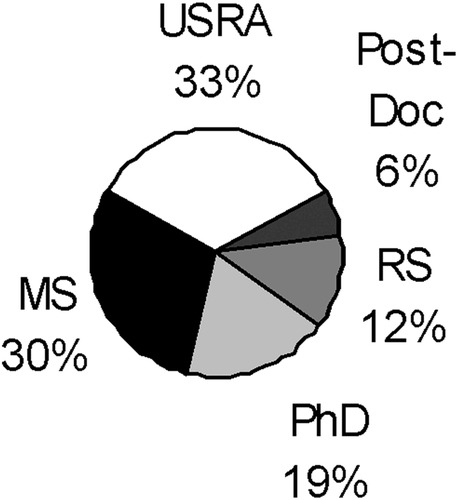
Figure 3. Distribution and growth of the undergraduate student research assistant programs (USRA) in Brazil. (A) Number of USRA fellowships granted during the last 20 yr. (B) Comparison between total number of USRA fellowships (filled circles) and total number of undergraduate students (open circles). (C) Ratio of USRA fellowships to undergraduate students during the last 24 yr.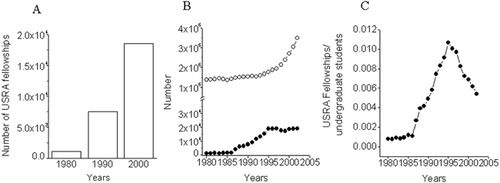
In the last 3 yr, approximately 60 percent of former USRAs followed the academic route into graduate programs (CNPq, 2002). This is a much higher percentage than shown in Figure 3C, suggesting that the undergraduate research assistant programs influence these students' choice of career. The role of the advisor in a Brazilian laboratory is perhaps the very essence of the success of the undergraduate research assistant program in Brazil. Most advisors began their careers early and in the same way as today's students: in universities suffering under the limitations of doing research in a developing country such as Brazil. In this country it is extremely difficult not only to set up a new laboratory but also to perform research in areas of science progressing rapidly and requiring new technologies. The motivating environment produced by the spirit of challenge and the willingness of these advisors to transfer their experience to their students inspires many students to look for intensive experimental and theoretical work as undergraduate research assistants and later as graduate students (Halaby, 2001; Malachowski, 1996).
It is curious, however, that according to the CNPq, only about 10 percent of these former URSAs actually conclude their M.S. or Ph.D. This number shows a tendency to increase lately in some regions of the country, but it is also true that the students who choose the academic route witness at close range the anguish of their older colleagues' worrying about their own future. The newly minted Ph.D. faces serious dilemmas of short-term contracts, low pay, and lack of career prospects in academic institutions (de Meis et al., 2003b; Lawrence, 2003, Ribeiro et al., 2001). Academia is basically their only option after completing postdoctoral work. In fact, this is an important field to be improved in a developing country that still has difficulty in guaranteeing its citizens a full education (Bonalume, 2001). The low level of state support not only for research and development but also for educational programs still raises concerns in Brazil (Pinheiro-Machado and De Olivéira, 2001). Luiz Inácio Lula da Silva, the Brazilian president, wants to transform Brazil's ability to use science and technology for its economic development (Adam, 2003; Nature Publishing Group, 2003). The president's idea of spreading research funding around the country, although it seems to be fair enough, should not restrict development in the south and southeast in an effort to improve development in the north or northeast. Instead, the funding for scientific research should be distributed so as to maintain the high level of the present graduate programs and at same time stimulate the establishment of new ones (Macilwain and Neto, 2000).
Figure 4. Distribution of undergraduate student research assistants (USRAs) in Brazil.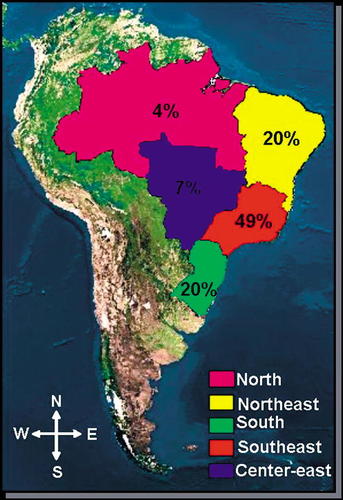
FEDERAL AND STATE PROGRAMS FOR SCIENCE
The beginning of the millennium suggested a cloudy future for research groups in the southern part of Brazil, according to Dr. José Luiz Monteiro, the Dean for Research and Graduate Studies at the Federal University of Rio de Janeiro, which is one of the top 10 Brazilian universities and is located in the Southeast. Together with two other universities in this region, Federal University of Rio de Janeiro was responsible for 43 percent of the Brazilian articles indexed by the Institute for Scientific Information between 1997 and 2000 (de Meis et al., 2003). In 2003, during a meeting of the university council for undergraduate teaching, Monteiro presented data showing that the number of M.S. fellowships granted to Federal University of Rio de Janeiro by CAPES and CNPq had decreased by 42 percent and 64 percent, respectively, since 1994. In addition, the value of these fellowships, after correcting for inflation, has fallen so low that students need to find part-time jobs in order to retain financial independence. To make things worse, Fundação Carlos Chagas Filho de Amparo à Pesquisa do Estado do Rio de Janeiro (FAPERJ), one of the most important foundations for funding research in Rio de Janeiro, had its budget cut 50 percent by the state government (FAPERJ, 2003). If these trends continue, there will be fewer fellowships granted in the coming years, increasing the need for a program directed toward undergraduate and graduate students in the state of Rio de Janeiro.
Figure 5. Profile of the graduate course in Biological Chemistry at the Federal University of Rio de Janeiro. (Left) Classification of the course (arrow) in the evaluation of all Brazilian graduate courses. In 2003, CAPES ranked 2,988 graduate courses from level 1 to 7 in 2004. The black arrow points to the position of the Biological Chemistry course that is in the top 3.3 percent (Source: CAPES). (Right) Number of USRAs (○), graduate students (•), scientific publications (▵), and investigators/professors (▴) in the Biological Chemistry graduate course during its lifetime. Arrow shows the official starting date of the course, and asterisks (*) indicate the number of scientific publications in which at least one USRA is an author or coauthor.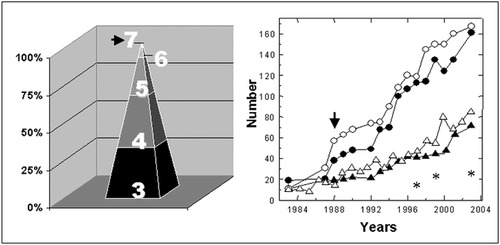
The new director for CAPES, Dr. Jorge Almeida Guimarães, has established some important new rules for the student fellowships in the graduate programs throughout Brazil. These include 1) an increase of 18 percent in the value of the fellowships; 2) permission for graduate students to teach part-time in the federal higher education system; and 3) letting technicians who enroll in graduate courses keep their technician fellowships. This is a sign that the government is keeping an eye on the financial problem that lies ahead for these students. Unfortunately, Brazilian research funding comes almost exclusively from public coffers. Perhaps a promising way to improve this situation would be for the government to encourage university–industry collaborations. In that manner, the scientific career can become more attractive, raising salaries and improving laboratories, without any further higher expenses for the government (Bonvillian, 2002).
A SUCCESSFUL EXAMPLE
In Brazil, the graduate courses are evaluated frequently by CAPES, which ranks them from 1 (lowest) to 7 (highest). The graduate program in Biological Chemistry at the Federal University of Rio de Janeiro, in the southeast of Brazil, is included in the small group (3.3 percent) that currently receives the highest score (Figure 5A). Interestingly, the contribution of USRAs to the research effort in this program is clearly detected when its development is analyzed. The evolution of this course is marked by simultaneous increases in the number of USRAs and graduate students, most of them former USRAs (Figure 5B). The participation of undergraduates as authors (Almeida et al., 2000; Souza et al., 2001; Torres et al., 1998) or coauthors (Ferrao-Gonzales et al., 2003; Guilherme et al., 1998) is evidence of their direct contribution to the achievement of a high-quality scientific research program. (Figure 5B). These articles are published in journals with an average impact factor of about 3.5, including Nature; FASEB Journal; Proceedings of the National Academy of Sciences, USA; Journal of Biological Chemistry; Journal of Molecular Biology and Biochemistry (Carneiro et al., 2003; Foguel et al., 1996; Ishimaru et al., 2003; Oliveira et al., 1999; Santos et al., 1999), as well as other more specialized journals of lower impact (data not shown).
Interviews and questionnaires were used to collect opinions from USRAs working in two of the top graduate and postgraduate programs in Cell and Molecular Biology, including the Biological Chemistry graduate program at the Federal University of Rio de Janeiro (Aguiar, 1997). These data convey an idea about the USRA's points of view concerning the USRA programs offered and how they can influence their personal and academic lives. On a scale from 1 (low) to 6 (high), the USRAs (n = 157) ranked practicing in big laboratories (5.4) and planning and developing projects (5.4) as the most important advantages of participating in these programs because these activities indirectly improve their performance in their formal coursework. Other positive aspects cited were the increase in knowledge (4.5) and the opportunity of correlate theoretical concepts with the real world (4.6).
According to these students, their experience as an USRA taught them how to study (4.4). Consequently they developed new learning strategies that improved their performance. Typical statements were: “I think that as an USRA I improved my reasoning. When I first entered college I just memorized without understanding. A week later I had forgotten everything. In the USRA program you have too many things to understand.” and “This program teaches you how to teach yourself, solve your own problems... and it teaches you to use books. It opens your mind.”
Some of the USRAs interviewed were disappointed or bored with their formal courses. They indicated that the USRA program creates an additional link between them and the university, providing satisfaction and motivation to go on and finish their formal courses. “In fact the USRA program inspired me to continue my undergraduate course. I think that without it I would not have been able to stand it, it would have been too boring.”
The USRAs also considered that the increasing amount of responsibility and the professional relationships among those working in the laboratories (5.3) undoubtedly would facilitate their future professional lives, helping them to reach maturity. Distinctive comments were: “You become an adult, questioning basic principles, such as why my advisor said this or that. Then you notice that this occurs in any professional environment. You learn how to grow up;” “You have to deal with schedules; sometimes you have to compromise and say `No, today I have to go to class...,' or `Today I have to go to the laboratory'... You learn to set priorities and to be clear about them in your own mind, even more for yourself than for other people;”“ When I am working in the lab I really concentrate. Or when I am waiting for an experiment to run, I am studying or reading but not talking or gossiping—not because I'm not happy, but because I need to use my time in a better way.”
In this work, we listed some URSA involved in URSA programs of different institutions (Table 1) and interviewed the students selected to enter the Master's program in Biological Chemistry in 2004. Eighty-two percent were former USRA. Most of them (60 percent) decided to pursue the academic route because they liked research and decided to stay in this career. “I was enjoying the research and wanted to continue;” “After my first contact with the laboratory environment I really enjoyed it;” “I liked the idea of doing research but the USRA program made me sure that it was what I really wanted to do.”
| USRA | Institutiona | Undergraduate course | Research project | Publications |
|---|---|---|---|---|
| Mariana Pujol-Luz | Fluminense Federal University | Medicine | Study of the molecular evolution of snake venom thrombin-like enzymes | Cellular and Molecular Life Science, 2004 |
| Leonardo S. Franco | Fundação Osvaldo cruz | Pharmacy | Involvement of monoxenous trypanosomatid species in opportunistic infections of immunocompromised individuals and cutaneos lesions in vertebrate hosts | The Journal of Eukaryotic Microbiology, in press |
| Daniela Paula Costa | Fluminense Federal University | Mathematics | Graphos and Games: an option for teaching mathematics | National Meeting of Applied and Computacional Mathematics, abstract accepted |
| Maria Elisa Cardoso de Almeida | Federal University of Rio de Janeiro | Portuguese/literature | Dengue and Internet: evaluation of sites and advertisements about an endemic disease | Manuscript in preparation |
Among the new crop of graduate students, some also saw a disadvantage: the full-time commitment demanded by the graduate program, which prevented them from holding another kind of job, even though they were not properly paid. However, most (70 percent) were not able to see a clear disadvantage, and they identified the graduate course as an extension of their formal courses. They felt that the graduate course would result in their being more qualified and knowing more than they did after their formal undergraduate courses.
CONCLUSION
The purpose of this study was to evaluate the role of the undergraduate student research assistant in Brazil. It revealed that the institutions benefit from training enthusiastic students via such undergraduate research assistants programs. Educational institutions within not only health sciences but also other important areas are going to face a major generational change among the scientific staff within the coming 5–10 yr in Brazil. They are therefore worrying that undergraduate students might refrain from choosing (or continuing) a university research career. Information about the career choices and marital and social statuses of USRAs are still not available but could help to guide future aid research programs. The situation might be improved by focusing on the formation of new researchers, to ensure an optimal balance in the distribution of research faculty across the country. It is evident that the Brazilian government should not only promote the training of USRAs but also encourage Ph.D.s and young scientists in order to guarantee the scientific and technologic development of Brazil.
FOOTNOTES
Monitoring Editor: Gordon Uno
ACKNOWLEDGMENTS
We thank Dr. Martha Sorenson and Dr. Maria José Alvim-Gaston for their suggestions, support, and careful revision of the manuscript. This study was supported by CNPq, FAPERJ, Fundação José Bonifácio (FUJB), CAPES, and Universidade Federal Fluminense (Brazil).


